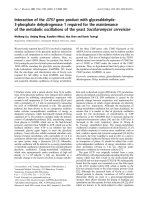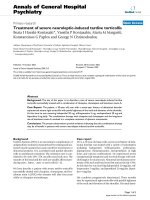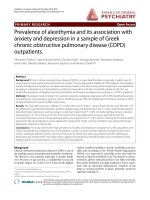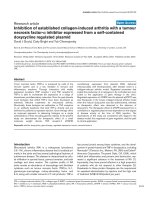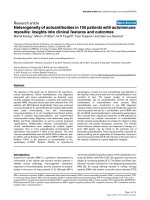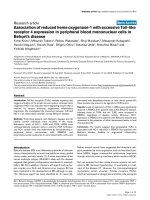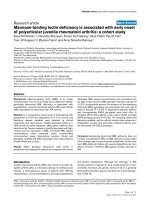Báo cáo y học: " Outcome of severe lactic acidosis associated with metformin accumulation" potx
Bạn đang xem bản rút gọn của tài liệu. Xem và tải ngay bản đầy đủ của tài liệu tại đây (230.44 KB, 5 trang )
RESEARCH Open Access
Outcome of severe lactic acidosis associated with
metformin accumulation
Sigrun Friesecke
1*
, Peter Abel
1
, Markus Roser
2
, Stephan B Felix
1
, Soeren Runge
3
Abstract
Introduction: Metformin associated lactic acidosis (MALA) may complicate metformin therapy, particularly if
metformin accumulates due to renal dysfunction. Profound lactic acidosis (LA) generally predicts poor outcom e.
We aimed to determine if MALA differs in outcome from LA of other origin (LAOO).
Methods: We conducted a retrospective analysis of all patients admitted with LA to our medical ICU of a tertiary
referral center during a 5-year period. MALA patients and LAOO patients were compared with respect to
parameters of acid-base balance, serum creatinine, hospital outcome, Simplified Acute Physiology Score II (SAPS II)
and Sequential Organ Failure Assessment (SOFA) score, using Pearson’s Chi-square or the Mann-Whitney U-test.
Results: Of 197 patients admitted with LA, 10 had been diagnosed with MALA. With MALA, median arterial blood
pH was significantly lower (6.78 [range 6.5 to 6.94]) and serum lactate significantly higher (18.7 ± 5.3 mmol/L) than
with LAOO (pH 7.2 0 [range 6.46 to 7.35], mean serum lactate 11.2 ± 6.1 mmol/L). Overall mortality, however, was
comparable (MALA 50%, LAOO 74%). Furthermore, survival of patients with arterial blood pH < 7.00 (N = 41) was
significantly better (50% vs. 0%) if MALA (N = 10) was the underlying condition compared to LAOO (N = 31).
Conclusions: Compared to similarly severe lactic acidosis of other origin, the prognosis of MALA is significantly
better. MALA should be considered in metformin-treated patients presenting with lactic acidosis.
Introduction
Metformin is recommended as the treatment of choice
in patients with type 2 diabetes mellitus because it
decreases cardiovascular morbidity and mortality [1,2].
Nevertheless, metformin-associated lactic acidosis
(MALA) is a rare but potentially life-threatening compli-
cation with a mortality rate of 30% to 50% [3,4]. The
biochemical mechanism of MALA is still not full y
understood. Presumably, accumulated metformin sup-
presses biological oxidation and the enzymes of the
citric acid cycle [3,5-7]. Moreover, recent studies have
reported that metformin action may be mediated by the
regulation of gene expression [8-10]. T he pathogenesis
of MALA is controversial. MALA is assumed to be trig-
gered by an acute primary tissue hypoxia as in septic
shock or cardiovascular failure in most cases [1,3,11,12].
Some authors d ispute whether m etformin may contri-
bute to lactic acidosis (LA) at all [12,13]. However, cases
of MALA solely following drug accumulation have been
reported [5,14-16]. Furthermore, data from a US poison
center give some evidence that a large single ingestion
can lead to LA [17]. R emarkably, severe MALA may
have an unexpectedly favorable outcome [4,14,15].
Therefore, the aim of this study was to compare the
outcomes of MALA and LA of other origin (LAOO).
Materials and methods
This retrospective analysis was approved by the institu-
tional ethics committee at Ernst Moritz Arndt University
of Greifswald. The necessity of patient consent was
waived. All patients admitted to the medical intensive
care unit of our tertiary referral center during a 5-year
period (2004 to 2008) were screened for LA (that is, lac-
tate of greater than 5 mmol/L and pH of not more than
7.35 [11]) on admission by using the laboratory database.
Clinical characteristics, admission laboratory results,
metformin plasma levels, and hospi tal survival of a ll LA
patients were extracted from patient files. To compare
severity of disease, Simplified Acute Physiology Score II
(SAPS II) [18,19] and Sequential Organ Failure
* Correspondence:
1
Department of Cardiology, Pneumology and Intensive Care Medicine, Ernst
Moritz Arndt University, 17475 Greifswald, Germany
Full list of author information is available at the end of the article
Friesecke et al. Critical Care 2010, 14:R226
/>© 2010 Friesecke et al.; licens ee BioMed Central Ltd. This is an open access article distributed under the terms of the Creative
Commons Attribution License ( which permits unrestricted use, distribution, and
reproduction in any medium, provided the original work is pr operly cited.
Assessment (SOFA) score [20,21] were e xtracted from
the ward database. According to discharge diagnoses,
patients were categorized under the following entities of
LA: MALA, post-cardiopulmonary resuscitation, septic
shock, cardiogenic shock, acute mesenteric ischemia,
hemorrhagic shock, or other. The diagnosis of MALA
was confirmed retrospectively by critical review of
patient charts, which included data on medical history,
clinical presentation, highly elevated plasma levels of
metformin, and absence of other common causes of LA.
None of the patients had evidence of hepatic failure. All
MALA patients had an elec trocardiogram and a bedside
echocardiogram to rule out myocardial infarction and
relevant cardiac dysfunction. None had evidence of a
septic focus in chest x-ray, abdo minal or thoracic ultra-
sound, blood cultures, urinary dipstick (if not anuric), or
computed tomography (if indicated). MALA patients
were compared with all LAOO patients and wit h the
severely acidotic subgroup (pH < 7.0) of LAOO patients
with respect to parameters of acid-base balance, serum
creatinine, SAPS II, and hospital outcome by using the
Pearson chi-square test or the Mann-Whitney U test.
Results
During the study period, 197 patients were admitted with
LA. M ALA was dia gnosed in 1 0 patients, none had d eliber-
ately overdosed (daily metformin dose of 1,900 ± 356 mg),
but all had severe renal failure (median admission serum
creatinine of 776 μmol/L, range of 347 to 1,502) that had
not been noticed before. In 6 patients, previous diarrhea or
vomiting or both were reported; in the other 4, no caus e
for acute renal failure could be identified, but 3 of them
had pre-existing chronic renal insufficiency. Metformin
plasma levels were highly toxic in a ll MALA patients (med-
ian of 55 mg/L, range of 31 to 85, therapeutic range of 0.2
to 1.3). All MALA patients were in circulatory shock and
were treated with vasopressors. Nevertheless, in 8 of them,
circulatory failure deteriorated up to cardiocirculatory
arrest, which was reversible with cardiopulmonary resusci-
tation. All MALA patients were mechanically ventilated
and immediately treated with continuous veno-venous
hemodialysis or hemofiltration. In MALA, LA and renal
dysfunction were significantly more severe, other organ
dysfunctions were similar, but mortality was not signifi-
cantly higher compared with all LAOO patients and with
each of the causal e ntities of LAOO (Table 1).
All MALA patients and 31 of the LAOO patients had
very severe acidosis (pH < 7.0). In this subgroup, acid-
base imbalance in MALA was still slightly more profound
than in LAOO, severity of disease and non-renal organ
dysfunction (SAPS II and SOFA score) were comparable,
but outcome was significantly better (50% survivors in
MALA versus 0% in LAOO) (Table 2).
There was no difference within the MALA group
between survivors and non-survivors in regard to serum
metfo rmin level, the degree of LA, or or gan dysfunction
Table 1 Comparison of patients with metformin-associated lactic acidosis with patients with lactic acidosis of
other origin
All
patients
(n = 197)
MALA
(n = 10)
LAOO
(n = 187)
Post-
cardiac
arrest
(n = 72)
Septic
shock
(n = 42)
Cardiogenic
shock
(n = 39)
Mesenteric
ischemia
(n =8)
Hemorrhagic
shock
(n = 13)
Other
causes
(n = 13)
Age, years 67 ± 13 66 ± 9 67 ± 13 65 ± 13 68 ± 12 73 ± 11 72 ± 9 64 ± 15 56 ± 14
Male gender 121 (61%) 4 (40%) 117 (63%) 45 (62%) 24 (57%) 26 (67%) 6 (75%) 7 (54%) 9 (69%)
SAPS II 74 ± 20 88 ± 23 73 ± 19
a
81 ± 16 71 ± 19
a
75 ± 18 73 ± 25 54 ± 15
b
54 ± 14
b
SOFA score 12.5 ± 3.6 14.3 ± 1.4 12.4 ± 3.7 12.9 ± 2.9 12.1 ± 4.5 11.8 ± 2.8
b
14.4 ± 4.4 13.4 ± 4.6 9.6 ± 4.2
b
Respiratory 2.5 ± 1.0 2.7 ± 0.9 2.5 ± 1.0 2.7 ± 0.9 2.1 ± 1.3 2.4 ± 0.6 2.6 ± 1.1 2.3 ± 1.5 2.2 ± 1.4
Renal 2.4 ± 1.2 4.0 ± 0.0 2.3 ± 1.2
b
2.1 ± 1.2
b
2.5 ± 1.2
b
2.5 ± 1.1
b
2.8 ± 0.8
a
2.1 ± 1.5
b
1.9 ± 1.3
b
Hepatic 0.7 ± 1.0 0.3 ± 0.7 0.7 ± 1.0 0.3 ± 0.6 1.3 ± 1.2
a
0.6 ± 0.8 0.6 ± 0.9 1.8 ± 1.7 0.9 ± 0.9
Cardiovascular 3.3 ± 1.4 4.0 ± 0.0 3.3 ± 1.5 3.5 ± 1.3 3.2 ± 1.5 3.4 ± 1.5 4.0 ± 0.0 2.9 ± 1.8 2.1 ± 2.0
a
Hematologic 0.9 ± 1.2 0.5 ± 0.8 0.9 ± 1.2 0.6 ± 0.9 1.3 ± 1.4 0.3 ± 0.7 2.2 ± 1.6 2.6 ± 1.1 0.9 ± 1.2
Neurologic 2.7 ± 1.4 2.8 ± 1.5 2.7 ± 1.4 3.7 ± 0.6
a
1.7 ± 1.3
a
2.8 ± 1.2 2.2 ± 1.3 1.8 ± 1.4
b
1.6 ± 1.2
Lactate, mmol/L 11.6 ± 6.2 18.7 ± 5.3 11.2 ± 6.1
b
12.8 ± 6.1
b
8.7 ± 4.5
b
10.9 ± 5.2
b
8.6 ± 3.3
b
13.5 ± 9.5
b
10.8 ± 7.1
b
pH 7.13 ± 0.19 6.75 ±
0.13
7.15 ±
0.17
b
7.07 ± 0.19
b
7.23 ± 0.09
b
7.18 ± 0.14
b
7.27 ± 0.04
b
7.26 ± 0.07
b
7.14 ± 0.18
b
Bicarbonate,
mmol/L
14.6 ± 5.9 4.4 ± 2.4 15.2 ± 5.6
b
14.5 ± 5.6
b
16.6 ± 5.8
b
14.9 ± 4.0
b
16.2 ± 1.8
b
15.8 ± 5.7
b
14.1 ± 8.8
b
Creatinine, μmol/L 307 ± 265 796 ± 324 227 ± 141
b
169 ± 128
b
318 ± 181
b
182 ± 48
b
299 ± 125
a
303 ± 122
a
214 ± 57
b
Survival 52 (26%) 5 (50%) 48 (26%) 19 (26%) 9 (21%) 9 (23%) 0 5 (38%) 6 (46%)
Values are presented as mean ± standard deviation or as number (percentage). Comparison with metformin-associated lactic acidosis (MALA):
a
P < 0.05,
b
P <
0.01. Simplified Acute Physiology Score II (SAPS II) and Sequential Organ Failure Assessment (SOFA) score were measured on admission. Other causes of lactic
acidosis were respiratory exhaustion (3), alcoholic lactic acidosis (3), acute liver failure (2), status epilepticus (2), anaphylactic shock, hypovolemic shock, and
disseminated intravascular coagulation in acute myeloid leukemia. LAOO, lactic acidosis of other origin.
Friesecke et al. Critical Care 2010, 14:R226
/>Page 2 of 5
(Table 3). MALA patients who did not survive died
from refractory circulatory failure after a median of
27 hours (range of 3 to 41 hours) from intensive care
unit admission.
Discussion
In 10 out of 197 patients in our study, LA on admission
was found to be associated with metformin accumula-
tion. MALA patients had the most severe acid-base
imbalance but did not have a worse outcome. Mortality
rates in our study are in accordance with those pub-
lished by other authors. For MALA, a mortality of 30%
to 50% has been r eported [3,4,22]; for LA in genera l, a
mortality of up to 83% has been reported [23,24].
Mortality is generally correlated with lactate levels
[24,25]. For MALA, data are less clear. After a retrospec-
tive analysis in 1999, Lalau and Race [25,26] reasoned
that neither lactate nor metformin levels were of prog-
nostic value in MALA since, in their study, the lactate
and metformin levels of survivors were, respectively,
similar to and higher than those of patients who died.
The authors suppose that the underlying condition, and
not metformin accumulation, determined outcome. In
contrast, Dell’Aglio and colleagues [27] report ed a corre-
lation between pH nadir, metformin level, and outcome.
Recently, observations in two series of MALA were
published [4,22]. Peters and colleagues [ 22] reported
30 patients who were generally less sick than ours (less
Table 3 Comparison of survived versus deceased patients with metformin-associated lactic acidosis
All patients with MALA (n = 10) Survived (n = 5) Deceased (n =5)
Age, years 66 ± 9 64 ± 5 69 ± 11
Male gender 4 (40%) 3 (60%) 1 (20%)
SAPS II 88 ± 23 73 ± 25 103 ± 7
SOFA score 14.3 ± 1.4 13.8 ± 1.5 14.8 ± 1.3
Respiratory 2.7 ± 0.9 2.4 ± 1.1 3.0 ± 0.7
Renal 4.0 ± 0.0 4.0 ± 0.0 4.0 ± 0.0
Hepatic 0.3 ± 0.7 0.4 ± 0.9 0.2 ± 0.4
Cardiovascular 4.0 ± 0.0 4.0 ± 0.0 4.0 ± 0.0
Hematologic 0.5 ± 0.8 0.4 ± 0.9 0.6 ± 0.9
Neurologic 2.8 ± 1.5 2.6 ± 1.3 3.0 ± 1.7
Lactate, mmol/L 18.7 ± 5.3 17.7 ± 5.3 19.8 ± 5.7
pH 6.75 ± 0.13 6.72 ± 0.17 6.77 ± 0.07
Prothrombin activity, % 69.1 ± 27.7
a
78.0 ± 24.6 58.0 ± 30.7
a
Serum metformin, mg/L 55 ± 13 52 ± 7 58 ± 19
Values other than ‘Male gender’, which is presented as number (percentage), are presented as mean ± standard deviation.
a
One patient was omitted with 11%
prothrombin activity due to cumarin therapy. MALA, metformin-associated lactic acidosis; SAPS II, Simplified Acute Physiology Score II; SOFA, Sequential Organ
Failure Assessment.
Table 2 Comparison of metformin-associated lactic acidosis and very severe lactic acidosis of other origin (pH < 7.0)
All patients with pH < 7.0 (n = 41) MALA (n = 10) LAOO (n = 31)
Age, years 64 ± 13 66 ± 9 64 ± 14
Male gender 19 (46%) 4 (40%) 15 (48%)
SAPS II 84 ± 18 88 ± 23 83 ± 16
SOFA score 14.0 ± 2.9 14.3 ± 1.4 13.8 ± 3.4
Respiratory 2.7 ± 1.0 2.7 ± 0.9 2.8 ± 1.0
Renal 3.0 ± 1.1 4.0 ± 0.0 2.6 ± 1.1
a
Hepatic 0.5 ± 0.8 0.3 ± 0.7 0.6 ± 0.9
Cardiovascular 3.6 ± 1.2 4.0 ± 0.0 3.4 ± 1.4
Hematologic 0.8 ± 1.1 0.5 ± 0.8 0.9 ± 1.2
Neurologic 3.3 ± 1.2 2.8 ± 1.5 3.5 ± 1.1
Lactate, mmol/L 18.1 ± 6.5 18.7 ± 5.3 17.9 ± 6.9
pH 6.83 ± 0.12 6.75 ± 0.13 6.86 ± 0.11
a
Bicarbonate, mmol/L 9.0 ± 4.8 4.4 ± 2.4 10.5 ± 4.5
a
Creatinine, μmol/L 529 ± 392 796 ± 324 195 ± 91
a
Survival 4 (10%) 5 (50%) 0 (0%)
a
Values are presented as mean ± standard deviation or as number (percentage). Comparison with metformin-associated lactic acidosis (MALA):
a
P < 0.01. LAOO,
lactic acidosis of other origin; SAPS II, Simplified Acute Physiology Score II; SOFA, Sequential Organ Failure Assessment.
Friesecke et al. Critical Care 2010, 14:R226
/>Page 3 of 5
acidotic, less frequently in shock, lower SAPS II, and
less frequently ventilated) and in whom mortality was
30% compared with our 50%. Seidowsky and colleagues
[4] reported 42 patients, 29 of whom had incidental
metformin accumulation. In these 29 patients, severity
of acidosis (mean pH of 6.9) and mortality (48.3%) were
comparable to those of our MALA patients [4]. In both
series, decreased prothrombin activity on admission was
associated with mortality [4,22]. In our small number of
cases, we could not reproduce this association.
Compared with our LAOO subgroup with similarly
severe acid-base imbalance (pH < 7.0), the outcome of
MALA patients was significantly better. Lalau and Race
[28] reported decreased mortality for patients who had a
pH of less than 7 and who had been treated with met-
formin (81% versus 99%) and th is is consistent with our
results.
We suppose that the different outcomes of MALA and
LAOO may have been because, unlike most cases of
LAOO,LAinMALAisnotdueprimarilytoshockor
ischemia and because our patients had no underlying
condition serious enough to cause severe LA in the
absence of metformin accumulation. Furthermore, it has
been hypothesized that metformin, possibly through its
beneficial effects on vasomotili ty, might even be pr otec-
tive in shock [26,29].
MALA may develop without an underlying disease or
may aggravate LAOO, or metformin may accumulate just
coinc identally with LA [3,12]. In any given patient, it will
be difficult to establish the causative role of metformin
accumulation in the development of LA [4]. Further-
more, the role of metformin in the development of LA is
controversi al; some authors deny any causal involvem ent
[12,13] altogeth er, and others belie ve that metformin
actually induces LA in certain cases [30]. Clinica l data in
general and our retrospective observation in particular
are not suitable to decide this issue definitely, but our
results and those of other authors point to the latter posi-
tion [4,5,14-17,22,27]. In our MALA patients, no o ther
cause for LA was identified, andhighlyelevatedmetfor-
min plasma levels were measured. In these patients, pre-
viously unnoticed deterioration of renal function
explained why metformin had accumulated despite hav-
ing been taken in usual doses. The much greater extent
of renal dysfunction in MALA compared with similarly
severe LAOO suggests that renal failure not only
complicated MALA but also indeed contributed to the
pathogenesis. Progressive renal impairment has been
recogni zed as a risk factor for MALA [14,15,30] and can-
not be held responsible for LA as a single condition in
the absence of metformin [31].
MALA may be more common in severely acidotic
patients: 24% of our patients with pH of less than 7
were diagnosed with MALA. Therefore, given the
unexpectedly favorable prognosis , it a ppears important
to consider MALA and look into the possibility of met-
formin therapy when a patient is admitted with very
severe LA. It may be safely assumed that, in such
severely ill patients, only prompt and rigorous therapy
allows this favorable prognosis [14]. Anecdotal eviden ce
suggests that high-volume renal replacement therapy
may be beneficial in severe MALA [5,32,33].
Limitations
Our study included a limited number of patients. The
incidence of MALA is low, and therefore recruitment of
patients is demanding. In this study, we included 10
patients seen in one institution during a 5-year period.
A second limitation is the retrospective design. A bias in
patient selection cannot be excluded. As metformin
levels were usually not determined in cases in which
alternative causes of LA had been identified, coincident
metformin accumulation may have been missed. To our
knowledge, though, this is the first direct comparison
between MALA and LAOO.
Conclusions
The outcome of very severe MALA (pH < 7) is much
better than might be expected from the comparison
with similarly severe LAOO. To ensure adequate ther-
apy, it appears important to consider an association
with metformin and look into the possibility of metfor-
min medication in all cases of very severe LA.
Key messages
• Given the same profound level of acidosis, prog-
nosis of metformin-associated lactic acidosis
(MALA) is significantly better than that of lactic
acidosis of other origin.
• It is important to consider MALA in any metfor-
min-treated patient and to start therapy promptly.
Abbreviations
LA: lactic acidosis; LAOO: lactic acidosis of other origin; MALA: metformin-
associated lactic acidosis; SAPS II: Simplified Acute Physiology Score II; SOFA:
Sequential Organ Failure Assessment.
Author details
1
Department of Cardiology, Pneumology and Intensive Care Medicine, Ernst
Moritz Arndt University, 17475 Greifswald, Germany.
2
Department of Clinical
Chemistry and Laboratory Medicine, Ernst Moritz Arndt University, 17475
Greifswald, Germany.
3
Department of Gastroenterology, Nephrology,
Endocrinology, Nutrition, Ernst Moritz Arndt University, 17475 Greifswald,
Germany.
Authors’ contributions
S Friesecke conceived of the study and helped to draft the manuscript. PA
participated in the design of the study and performed the statistical analysis.
MR carried out data collection and data analysis. S Felix participated in the
design and coordination of the study. SR participated in the design of the
study and drafted the manuscript. All authors read and approved the final
manuscript.
Friesecke et al. Critical Care 2010, 14:R226
/>Page 4 of 5
Competing interests
The authors declare that they have no competing interests.
Received: 7 May 2010 Revised: 14 July 2010
Accepted: 20 December 2010 Published: 20 December 2010
References
1. Jones GC, Macklin JP, Alexander WD: Contraindications to the use of
metformin. BMJ 2003, 326:4-5.
2. Effect of intensive blood-glucose control with metformin on
complications in overweight patients with type 2 diabetes (UKPDS 34).
UK Prospective Diabetes Study (UKPDS) Group. Lancet 1998, 352:854-865.
3. Kirpichnikov D, McFarlane SI, Sowers JR: Metformin: an update. Ann Intern
Med 2002, 137:25-33.
4. Seidowsky A, Nseir S, Houdret N, Fourrier F: Metformin-associated lactic
acidosis: a prognostic and therapeutic study. Crit Care Med 2009,
37:2191-2196.
5. Chang CT, Chen YC, Fang JT, Huang CC: Metformin-associated lactic
acidosis: case reports and literature review. J Nephrol 2002, 15:398-402.
6. Leverve XM, Guigas B, Detaille D, Batandier C, Koceir EA, Chauvin C,
Fontaine E, Wiernsperger NF: Mitochondrial metabolism and type-2
diabetes: a specific target of metformin. Diabetes Metab 2003, 29:6S88-94.
7. Dykens JA, Jamieson J, Marroquin L, Nadanaciva S, Billis PA, Will Y:
Biguanide-induced mitochondrial dysfunction yields increased lactate
production and cytotoxicity of aerobically-poised HepG2 cells and
human hepatocytes in vitro. Toxicol Appl Pharmacol 2008, 233:203-210.
8. Caton PW, Nayuni NK, Kieswich J, Khan NQ, Yaqoob MM, Corder R:
Metformin suppresses hepatic gluconeogenesis through induction of
SIRT1 and GCN5. J Endocrinol 2010, 205:97-106.
9. Fujita Y, Hosokawa M, Fujimoto S, Mukai E, Abudukadier A, Obara A,
Ogura M, Nakamura Y, Toyoda K, Nagashima K, Seino Y, Inagaki N:
Metformin suppresses hepatic gluconeogenesis and lowers fasting
blood glucose levels through reactive nitrogen species in mice.
Diabetologia 2010, 53:1472-1481.
10. Kim YD, Park KG, Lee YS, Park YY, Kim DK, Nedumaran B, Jang WG, Cho WJ,
Ha J, Lee IK, Lee CH, Choi HS: Metformin inhibits hepatic gluconeogenesis
through AMP-activated protein kinase-dependent regulation of the
orphan nuclear receptor SHP. Diabetes 2008, 57:306-314.
11. Salpeter SR, Greyber E, Pasternak GA, Salpeter EE: Risk of fatal and nonfatal
lactic acidosis with metformin use in type 2 diabetes mellitus:
systematic review and meta-analysis. Arch Intern Med 2003,
163:2594-2602.
12. Misbin RI: The phantom of lactic acidosis due to metformin in patients
with diabetes. Diabetes Care 2004, 27:1791-1793.
13. Holstein A, Stumvoll M: Contraindications can damage your health–is
metformin a case in point? Diabetologia 2005, 48:2454-2459.
14. Fitzgerald E, Mathieu S, Ball A: Metformin associated lactic acidosis. BMJ
2009, 339:b3660.
15. Runge S, Mayerle J, Warnke C, Robinson D, Roser M, Felix SB, Friesecke S:
Metformin-associated lactic acidosis in patients with renal impairment
solely due to drug accumulation? Diabetes Obes Metab
2008, 10:91-93.
16. Velzen A, Riel A, Vries I, Meulenbelt J: The dangers of metformin: fatal
lactic acidosis with therapeutic use due to renal failure. Toxicol Lett 2008,
180:S142-S143.
17. Wills BK, Bryant SM, Buckley P, Seo B: Can acute overdose of metformin
lead to lactic acidosis? Am J Emerg Med 2010, 28:857-861.
18. Le Gall JR, Lemeshow S, Saulnier F: A new Simplified Acute Physiology
Score (SAPS II) based on a European/North American multicenter study.
JAMA 1993, 270:2957-2963.
19. Le Gall JR, Neumann A, Hemery F, Bleriot JP, Fulgencio JP, Garrigues B,
Gouzes C, Lepage E, Moine P, Villers D: Mortality prediction using SAPS II:
an update for French intensive care units. Crit Care 2005, 9:R645-652.
20. Vincent JL, de Mendonca A, Cantraine F, Moreno R, Takala J, Suter PM,
Sprung CL, Colardyn F, Blecher S: Use of the SOFA score to assess the
incidence of organ dysfunction/failure in intensive care units: results of
a multicenter, prospective study. Working group on “sepsis-related
problems” of the European Society of Intensive Care Medicine. Crit Care
Med 1998, 26:1793-1800.
21. Vincent JL, Moreno R, Takala J, Willatts S, De Mendonca A, Bruining H,
Reinhart CK, Suter PM, Thijs LG: The SOFA (Sepsis-related Organ Failure
Assessment) score to describe organ dysfunction/failure. On behalf of
the Working Group on Sepsis-Related Problems of the European Society
of Intensive Care Medicine. Intensive Care Med 1996, 22:707-710.
22. Peters N, Jay N, Barraud D, Cravoisy A, Nace L, Bollaert PE, Gibot S:
Metformin-associated lactic acidosis in an intensive care unit. Crit Care
2008, 12:R149.
23. Stacpoole PW, Wright EC, Baumgartner TG, Bersin RM, Buchalter S, Curry SH,
Duncan C, Harman EM, Henderson GN, Jenkinson S, et al: Natural history
and course of acquired lactic acidosis in adults. DCA-Lactic Acidosis
Study Group. Am J Med 1994, 97:47-54.
24. Smith I, Kumar P, Molloy S, Rhodes A, Newman PJ, Grounds RM,
Bennett ED: Base excess and lactate as prognostic indicators for patients
admitted to intensive care. Intensive Care Med 2001, 27:74-83.
25. Lalau JD, Race JM: Lactic acidosis in metformin-treated patients.
Prognostic value of arterial lactate levels and plasma metformin
concentrations. Drug Saf 1999, 20:377-384.
26. Lalau JD, Race JM: Lactic acidosis in metformin therapy. Drugs 1999,
58(Suppl 1):55-60, discussion 75-82.
27. Dell’Aglio DM, Perino LJ, Kazzi Z, Abramson J, Schwartz MD, Morgan BW:
Acute metformin overdose: examining serum pH, lactate level, and
metformin concentrations in survivors versus nonsurvivors: a systematic
review of the literature. Ann Emerg Med 2009, 54:818-823.
28. Lalau JD, Race JM:
Metformin and lactic acidosis in diabetic humans.
Diabetes Obes Metab 2000, 2:131-137.
29. Gras V, Bouffandeau B, Montravers PH, Lalau JD: Effect of metformin on
survival rate in experimental sepsis. Diabetes Metab 2006, 32:147-150.
30. Fantus IG: Metformin’s contraindications: needed for now. CMAJ 2005,
173:505-507.
31. De Backer D: Lactic acidosis. Intensive Care Med 2003, 29:699-702.
32. Panzer U, Kluge S, Kreymann G, Wolf G: Combination of intermittent
haemodialysis and high-volume continuous haemofiltration for the
treatment of severe metformin-induced lactic acidosis. Nephrol Dial
Transplant 2004, 19:2157-2158.
33. Friesecke S, Abel P, Kraft M, Gerner A, Runge S: Combined renal
replacement therapy for severe metformin-induced lactic acidosis.
Nephrol Dial Transplant 2006, 21:2038-2039.
doi:10.1186/cc9376
Cite this article as: Friesecke et al.: Outcome of severe lactic acidosis
associated with metformin accumulation. Critical Care 2010 14:R226.
Submit your next manuscript to BioMed Central
and take full advantage of:
• Convenient online submission
• Thorough peer review
• No space constraints or color figure charges
• Immediate publication on acceptance
• Inclusion in PubMed, CAS, Scopus and Google Scholar
• Research which is freely available for redistribution
Submit your manuscript at
www.biomedcentral.com/submit
Friesecke et al. Critical Care 2010, 14:R226
/>Page 5 of 5

